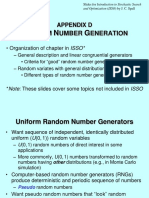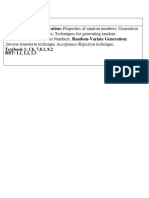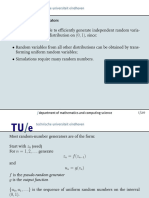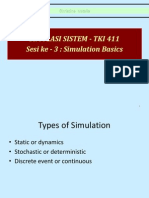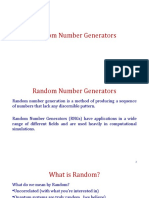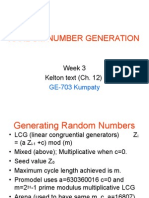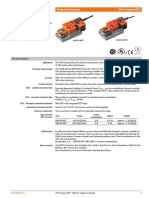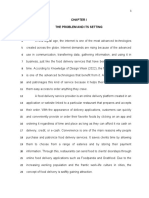4/2/2024
EMÜ322
Simulation Modeling and Analysis
Random Number & Random Variate
Generation
Banu Yuksel Ozkaya
Hacettepe University
Department of Industrial Engineering
1
Random Number Generators
• Random numbers are necessary ingredients in
the simulation of almost all discrete systems.
• A simulation of any system or process in which
there are inherently random components
requires a method of generating or obtaining
numbers that are random in some sense.
1
4/2/2024
Random Number Generators
• Example:
– Inter-arrival and service times in the single server
queuing system
– Travel times, loading times, weighing times in the
truck load system
– Newsday type and number of demands in each
newsday in the newsboy problem
Random Number Generators
• Generating Random Variates
– Uniform distribution on the interval [0 1], U(0,1)
– Random variates generated from the U(0,1)
distribution are called random numbers.
– Random variates from all other distributions
(normal, Poisson, gamma, binomial, geometric, ….)
can be obtained by transforming independent and
identically distributed random numbers
2
4/2/2024
Random Number Generators
• Properties of Random Numbers:
– A random number must be independently drawn
from a uniform distribution with pdf:
1, 0 x 1
f ( x) =
0, otherwise
1
1 x2
1
E ( R) = xdx = =
0 2 2
0
– Two important statistical properties:
• Uniformity
• Independence.
6
3
4/2/2024
Random Number Generators
• Mid-square method
– Start with a four-digit positive integer Z0 and find the square
of it to obtain an integer with up to eight digits. If necessary,
append zeros to the left to make it exactly 8 digits. Take the
middle four digits as the next four digit number, Z1 and etc.
i Zi Ui Zi2 i Zi Ui Zi2
0 7182 - 51581124 7 2176 0.2176 04734976
1 5811 0.5811 33767721 8 7349 0.7349 54007801
2 7677 0.7677 58936329 9 78 0.0078 00006084
3 9363 0.9363 87665769 10 60 0.0060 00003600
4 6657 0.6657 44315649 11 36 0.0036 00001296
5 3156 0.3156 09960336 12 12 0.0012 00000144
6 9603 0.9603 92217609 13 1 0.0001 00000001
7
4
4/2/2024
Random Number Generators
• Mid-square method
– One serious problem is that it has a strong
tendency to degenerate rapidly to zero and stay
there forever.
– A more fundamental objection to the mid-square
method is that it is not random, at all in the sense
of being unpredictable (This objection will apply to
all arithmetic generators)
Random Number Generators
• Generation of Pseudo-Random Numbers:
– Pseudo means false!!!
– False random numbers!!!
– If the method is known, the set of random
numbers can be replicated. Then, the numbers are
not truly random!
– The goal is to produce a sequence of numbers
between 0 and 1 that simulates, imitates the ideal
properties of uniform distribution and
independence as closely as possible.
10
5
4/2/2024
11
Random Number Generators
• Possible errors or departures from randomness
– The generated numbers might not be uniformly
distributed.
– The mean and/or the variance of the generated
numbers might be too high or too low.
– There might be dependence
• Autocorrelation between numbers
• Numbers successively higher or lower than adjacent
numbers
• Several numbers above the mean followed by several
numbers below the mean
12
6
4/2/2024
13
Random Number Generators
• A good arithmetic random number generator
should possess several properties:
– The numbers produced should appear to be
distributed uniformly on [0 1] (histogram) and
should not exhibit any correlation with each other.
– Fast and not requiring a lot of storage.
– Reproduce a given stream of random numbers
• Verification of the computer program
• Identical random numbers might be needed to compare
alternatives.
14
7
4/2/2024
Random Number Generators
• A good arithmetic random number generator
should possess several properties:
– Generators should be portable, e.g. to produce the
same sequence of random numbers on different
computers and compilers.
– Generators should have sufficiently long cycles
15
Random Number Generators
• Linear Congruential Generator (Lehmer 1951):
– A sequence of integers Z1,Z2,….. is defined by the
recursive formula
Z i +1 = (aZ i + c) mod m, i = 0,1,2,...
m: modulus, a: multiplier, c: increment, Z0: Seed or
starting value are all non-negative integers.
– What values can Zi‘s can take?
Zi
Ui = , i = 1,2,...
m
– What values can Ui‘s can take? 16
8
4/2/2024
17
Random Number Generators
• Linear Congruential Generator (Lehmer 1951):
– Z i +1 = (5Z i + 3) mod 16, i = 0,1,2,...
i Z i Ui i Zi Ui i Zi Ui
0 7 - 7 12 0.750 14 13 0.813
1 6 0.375 8 15 0.938 15 4 0.250
2 1 0.063 9 14 0.875 16 7 0.438
3 8 0.500 10 9 0.563 17 6 0.375
4 11 0.688 11 0 0.000 18 1 0.063
5 10 0.625 12 3 0.188 19 8 0.500
6 5 0.313 13 2 0.125 20 11 0.688
18
9
4/2/2024
19
Random Number Generators
• Linear Congruential Generator (Lehmer 1951):
– The looping behavior is obvious when Zi takes on a
value that it has had previously.
– The cycle repeats itself endlessly.
– The length of a cycle is the period of a generator.
– What is the maximum period of LCG?
20
10
4/2/2024
Random Number Generators
• Linear Congruential Generator (Lehmer 1951):
– If the period is m, LCG is said to have full period.
– Large scale simulations can use millions of random
numbers and hence, it is desirable to have LCG’s
with long periods.
– LCG has full period if and only if
• The only positive integer that exactly divides both m and
c is 1
• If q is a prime number that divides m, then q divides a-1.
• If 4 divides m, then 4 divides a-1.
21
Random Number Generators
• Linear Congruential Generator (Lehmer 1951):
1 1200
0.9
1000
0.8
0.7
800
0.6
i+1
0.5 600
U
0.4
400
0.3
0.2
200
0.1
0 0
0 0.1 0.2 0.3 0.4 0.5 0.6 0.7 0.8 0.9 1 0 0.1 0.2 0.3 0.4 0.5 0.6 0.7 0.8 0.9 1
Ui
a=16807, m=231-1, c=0, Z0=123457
22
11
4/2/2024
Random Number Generators
• Linear Congruential Generator (Lehmer 1951):
– Mixed Generator (c>0)
• Able to obtain full period
• Parameter choice➔ m=2b, c is odd, a-1 is divisible by 4.
Z0 is any integer between 0 and m-1
23
Random Number Generators
• Tests for Random Numbers
– The most direct way to test a generator is to use it
to generate some Ui’s, which are then examined
statistically to see how closely they resemble IID
U(0,1) random variates.
– The desirable properties are
• Uniformity
• Independence
24
12
4/2/2024
Random Number Generators
• Tests for Random Numbers
– Frequency Tests: Compare the distribution of the
set of numbers generated to a uniform distribution.
• Kolmogrov-Smirnov
• Chi-square test
– Autocorrelation Tests: Test the correlation
between numbers and compares the sample
correlation to the expected correlation (which is
zero)
25
Random Number Generators
• Tests for Uniformity
H0: Ri ~U[0,1]
H1: Ri ~U[0,1]
with significance level a=P(reject H0 | H0 is true)
– Rejecting H0 at a means that the numbers
generated do not follow a uniform distribution.
– Failing to reject H0 means that evidence of non-
uniformity has not been detected. This does not
imply that further testing for uniformity is
unnecessary.
26
13
4/2/2024
Random Number Generators
• Tests for Independence
H0: Ri ~Independently
H1: Ri ~Independently
with significance level a=P(reject H0 | H0 is true)
– Rejecting H0 at a means that the numbers
generated are not independent.
– Failing to reject H0 means that evidence of
dependence has not been detected by the test.
This does not imply that further testing for
independence is unnecessary.
27
tests
28
14
4/2/2024
Random Number Generators
• Tests for Uniformity
• Chi-Square Goodness of Fit Test:
– Suppose you have a sample of n generated
numbers between 0 and 1, U1,U2,….Un.
– n numbers are arranged in a frequency histogram
having k bins or class intervals.
– Let Oi be the frequency in the ith class interval and
Ei be the expected frequency in the ith class
interval.
29
30
15
4/2/2024
Random Number Generators
• Chi-Square Goodness of Fit Test:
– If the class intervals (n=10) are of equal length
(0.1), what is Ei ?
– If U1,U2,….Un are uniformly distributed on [0,1], the
test statistics c02 has a Chi-Square distribution with
k-1 degrees of freedom if n is large enough.
k
c 02 =
(Oi − Ei )2
i =1 Ei
31
Random Number Generators
• Chi-Square Goodness of Fit Test:
– H0: Ri ~U[0,1]
H1: Ri ~U[0,1]
– Reject H0 if c02 > c2a,k-1 where c2a,k-1 is the (1-a)th
percentile of a Chi-Square distribution with k-1
degrees of freedom.
32
16
4/2/2024
33
Random Number Generators
• Chi-Square Goodness of Fit Test:
34
17
4/2/2024
Random Number Generators
• Chi-Square Goodness of Fit Test:
– Example: n=100 numbers are generated.
10 intervals: [0,0.1),[0.1,0.2),…..[0.9,1]
Interval Oi Ei (Oi –Ei)2/Ei Interval Oi Ei (Oi –Ei)2/Ei
1 8 10 0.4 6 12 10 0.4
2 8 10 0.4 7 10 10 0.0
3 10 10 0.0 8 14 10 1.6
4 9 10 0.1 9 10 10 0.0
5 8 10 0.4 10 11 10 0.1
c02=3.4 < c20.05,9=16.9➔ fail to reject H0.
35
Random Number Generators
36
18
4/2/2024
Random Number Generators
• Chi-Square Goodness of Fit Test:
– How do we determine the class intervals?
• If the expected frequencies are too small, the test
statistic will not reflect the departure of observed
frequencies from expected frequencies.
• The minimum value of 5 are widely used as minimal
value of expected frequencies.
• If an expected frequency is too small, it can be
combined with the expected frequency in an adjacent
class interval.
• Class intervals are not required to be of equal width.
37
cent interval
38
19
4/2/2024
Random Number Generators
• Tests for Uniformity
• Kolmogrov-Smirnov Test (K-S test):
– The test compares the continuous cumulative
distribution function, F(x) of the uniform
distribution with the empirical cumulative
distribution function, Sn(x) of the sample of n
observations.
39
Random Number Generators
• Kolmogrov-Smirnov Test (K-S test):
– F(x)=x for 0≤x ≤1.
– The empirical cumulative distribution function,
Sn(x) is defined by
number of U1 , U 2 ,...., U n which are x
S n ( x) =
n
– As n becomes larger, Sn(x) should become a better
approximation to F(x) provided that the null
hypothesis is true.
40
20
4/2/2024
41
Random Number Generators
• Kolmogrov-Smirnov Test (K-S test):
– The K-S Test is based on the largest absolute
deviation between F(x) and Sn(x) over the range of
the random variable of interest.
D = max F ( x) − S n ( x)
42
21
4/2/2024
Random Number Generators
• Kolmogrov-Smirnov Test (K-S test):
– Rank the data from smallest to largest.
U(1) ≤ U(2) ≤ ……. ≤ U(n)
– Compute
i i − 1
D + = max − U (i ) , D − = maxU (i ) −
1i n n
1i n
n
– Compute D=max(D+,D-)
– If D>Da,n , reject H0. If D≤Da,n , conclude that no
difference has been detected between the true distribution
of U1,U2… Un and the uniform distribution.
43
44
22
4/2/2024
K-S critical value at a significance level
and n sample size
45
Random Number Generators
46
23
4/2/2024
Random Number Generators
• Kolmogrov-Smirnov Test (K-S test):
– Example: Five numbers 0.44, 0.81, 0.14, 0.05, 0.93
are generated.
U(i) 0.05 0.14 0.44 0.81 0.93
i/n 0.20 0.40 0.60 0.80 1.00
i/n-U(i) 0.15 0.26 0.16 - 0.07
U(i) –(i-1)/n 0.05 - 0.04 0.21 0.13
– D+ is the largest deviation of Sn(x) above F(x) – 0.26.
– D- is the largest deviation of Sn(x) below F(x) – 0.21.
– D=0.26< D0.05,5=0.565 ➔ fail to reject H0.
47
48
24
4/2/2024
Random Number Generators
• Comparison of Chi-Square Goodness of Fit Test
and Kolmogrov-Smirnov Test:
– Both tests are acceptable for testing the uniformity
of a sample of data provided that the sample size is
large.
– K-S test is more powerful of the two and is
recommended.
– K-S Test can be applied to smaller sample sizes.
– Chi-square goodness of fit tests are valid only for
large samples, say N≥50.
49
Random Number Generators
Test for Independence
50
25
4/2/2024
Random Number Generators
• Test for Independence
• Autocorrelation Test:
Autocorrelation Function for C6
(with 5% significance limits for the autocorrelations)
1.0
0.8
0.6
0.4
Autocorrelation
0.2
0.0
-0.2
-0.4
-0.6
-0.8
-1.0
1 2 3 4 5 6 7 8
Lag
51
52
26
4/2/2024
Random Number Generators
• Test for Independence
• Autocorrelation Test: Linear congruential generator
with a=16807, m=231-1, c=0, Z0=123457
Autocorrelation Function for C1
(with 5% significance limits for the autocorrelations)
1.0
0.8
0.6
0.4
Autocorrelation
0.2
0.0
-0.2
-0.4
-0.6
-0.8
-1.0
1 10 20 30 40 50 60 70 80 90 100 110 120 130 140
Lag 53
Random Number Generators
• Test for Independence
• Runs Test - Several versions
• Runs Test 1
– Examine the Ui sequence for unbroken sequences of
maximal length in which the Ui’s increase
monotonically (such a sequence is called a run-up).
– Consider the following sequence:
0.86, 0.11, 0.23, 0.03, 0.13, 0.06, 0.55, 0.64, 0.87, 0.10
Runs up of length 1 – 2 – 2 – 4 – 1
54
27
4/2/2024
55
56
28
4/2/2024
Random Number Generators
• Runs Test - Several versions:
• Runs Test 2
– Define
number of runs up of length i i = 1,2,3,4,5
ri =
number of runs up of length 6 i=6
– Runs up of length 1 – 2 – 2 – 4 – 1➔ r1=2, r2=2, r3=0,
r4=1, r5=0, r6=0
57
58
29
4/2/2024
Random Number Generators
• Runs Test - Several versions
• Runs Test 3
0.86, 0.11, 0.23, 0.03, 0.13, 0.06, 0.55, 0.64, 0.87, 0.10
Runs above and below K = 0.358
The observed number of runs = 4
The expected number of runs = 5.8
4 observations above K, 6 below
P-value = 0.206
Linear congruential generator with a=16807, m=231-1, c=0, Z0=123457
Runs above and below K = 0.501290
The observed number of runs = 4979
The expected number of runs = 5000.91
5021 observations above K, 4979 below
P-value = 0.661
59
__
x
60
30
4/2/2024
61
Random-Variate Generation
• Generation of a random-variate refers to the
activity of obtaining an observation on a
random variable from the desired distribution.
• It is now assumed that a distribution has been
specified somehow (distribution fitting) and we
address the issue of how we can generate the
random-variates with this distribution in order
to run the simulation model.
62
31
4/2/2024
Random-Variate Generation
• Example:
– Inter-arrival and service time in the single-server
queuing system
– Inter-arrival, loading, weighing and travel times in
the truck-load system
were needed for simulation of the corresponding
system.
63
Random-Variate Generation
• The basic ingredient needed for every method
of generating random variates from any
distribution or random process is a source of
independent and identically distributed U(0,1)
random variates (random numbers).
• Assume that a good source of random numbers
is available for use.
64
32
4/2/2024
Random-Variate Generation
• Factors to choose an algorithm to use:
– Exactness:
• Result in random variates with exactly the desired
distribution (within the limits of the machine accuracy)
– Efficiency:
• Use less storage space and execution time.
– Complexity:
• Overall complexity of the algorithm such as the
conceptual and implementation factors.
– Robustness:
• Efficient for all parameter values
65
Random-Variate Generation
• General Approaches:
– Inverse Transform
– Composition
– Convolution
– Acceptance-Rejection
66
33
4/2/2024
Random-Variate Generation
• Inverse-Transform Technique: Algorithm for
generating a continuous random-variate X
having distribution function F() is as follows:
1. Generate U~ U(0,1).
2. Compute X= F-1(U) (X s.t. F(X)=U).
F(x)
U
X
67
68
34
4/2/2024
Random-Variate Generation
• Inverse-Transform Technique:
– Example: How to generate an exponential random-
variate with parameter l?
1 − e − lx x0
F (x ) =
0 o.w.
1. Generate U~ U(0,1).
2. Compute X s.t. U=F(X)=1-e-lX ➔ X=-ln(1-U)/l.
(or X= -ln(U)/l)
69
70
35
4/2/2024
Random-Variate Generation
• Inverse-Transform Technique:
– Example: Generate 10000 exponential random
variates with l=2.
1200 3500
3000
1000
2500
800
2000
Frequency
600
1500
400
1000
200
500
0 0
0 0.1 0.2 0.3 0.4 0.5 0.6 0.7 0.8 0.9 1 0 1 2 3 4 5 6
X
– mean=0.5032, variance=0.2540 71
Random-Variate Generation
• Inverse-Transform Technique: Why does the
Inverse Transform Technique work?
Exponential density (l=2) Exponential distribution function (l=2)
2 1
1.8 0.9
1.6 0.8
1.4 0.7
1.2 0.6
F(x)
f(x)
1 0.5
0.8 0.4
0.6 0.3
0.4 0.2
0.2 0.1
0 0
0 0.5 1 1.5 2 2.5 3 3.5 4 0 0.5 1 1.5 2 2.5 3 3.5 4
x x
72
36
4/2/2024
Random-Variate Generation
• Example: Consider a random variable X that
has the following probability density function:
x 0 x 1
f ( x ) = 2 − x 1 x 2
0
o.w.
How do you generate this random variable by
inverse-transform method?
73
f(x)
x
74
37
4/2/2024
75
76
38
4/2/2024
Random-Variate Generation
• Inverse-Transform Method: Algorithm for
generating a discrete random-variate X taking
values x1,x2,…. where x1<x2<… and having
distribution function F() is as follows:
1. Generate U~ U(0,1).
2. Determine the smallest positive integer i such that
U≤ F(xi) and return X= xi.
77
78
39
4/2/2024
Random-Variate Generation
• Inverse-Transform Method:
1
X
0 X X
79
Random-Variate Generation
• Inverse-Transform Method:
• The value X returned by this technique has the
desired distribution F.
– i=1 ➔ X=x1 ↔ U ≤ F(x1) = p(x1)
– i≥2 ➔ X=xi ↔ F(xi-1) < U ≤ F(xi) →
P(X=xi)=P(F(xi-1) < U ≤ F(xi))= F(xi) - F(xi-1)= p(xi)
80
40
4/2/2024
(Slide #54)
81
Random-Variate Generation
• Inverse-Transform Method:
– Example: Generate 10000 geometric random
variates with p=1/5.
1200 4000
3500
1000
3000
800
2500
Frequency
600 2000
1500
400
1000
200
500
0 0
0 0.1 0.2 0.3 0.4 0.5 0.6 0.7 0.8 0.9 1 0 5 10 15 20 25 30 35 40 45 50
X
– mean=5.0280, variance=20.3314 82
41
4/2/2024
Random-Variate Generation
• Inverse-Transform Method:
– Example: In an inventory system, the demand sizes
are random taking on the values 1,2,3, and 4 with
respective probabilities 1/6, 1/3, 1/3 and 1/6.
83
F(x)
x
84
42
4/2/2024
Random-Variate Generation
• Inverse-Transform Method:
– Example:
1200 3500
3000
1000
2500
800
2000
600
1500
400
1000
200
500
0 0
0 0.1 0.2 0.3 0.4 0.5 0.6 0.7 0.8 0.9 1 1 2 3 4
– mean=2.5035, variance=0.9219
85
Random-Variate Generation
• Advantages of the Inverse Transform Method
1. Both valid to generate continuous and discrete
random variables➔ valid to generate mixed random
variables
X = min x : F ( x ) U
86
43
4/2/2024
Random-Variate Generation
• Advantages of the Inverse Transform Method
2. Can be used to generate correlated random
variables
• Positive correlation
• Negative correlation.
87
88
44
4/2/2024
Random-Variate Generation
• Disadvantages of the Inverse Transform
Method
– The need to calculate F-1(U) or F(U).
• Normal, gamma, beta distribution
– Usually not the fastest way to generate a random
variate.
89
Random-Variate Generation
• Convolution Method:
– A random variable X can be expressed as a sum of other
random variables that are independent and identically
distributed.
X = Y1 + Y2 + ....Ym
• Gamma (Erlang) random variable
• Binomial random variable
• Negative Binomial random variable
– X is said to be a m-fold convolution of the distribution of
Yj’s.
– Rather than generating X directly, generate m Y’s and
then sum them up.
90
45
4/2/2024
91
Random-Variate Generation
• Composition Method:
– When the distribution function F from which we
wish to generate can be expressed as a convex
combination of other distribution functions, the
composition technique works.
– Suppose we assume that for all x, F(x) can be written
as:
F ( x ) = p j F j ( x)
j =1
where Spj=1. Then,
f ( x ) = p j f j ( x)
j =1
92
46
4/2/2024
93
(Slide #61)
94
47
4/2/2024
Random-Variate Generation
• Composition Method:
1. Generate a positive random integer J, such that
P(J = j ) = p j
for j = 1,2,.....
➔ Select the distribution to generate the random
variate
2. Return X with distribution function Fj or density
function fj
➔ Generate the random variate from the selected
distribution function
95
Random-Variate Generation
• Composition Method:
• Example: The double exponential (or Laplace)
distribution has density as follows:
f (x ) = 0.5e x I ( −,0) ( x) + 0.5e − x I [0, ) ( x)
where IA is the indicator function of the set A,
defined by:
1 x A
I A ( x) =
0 o.w.
96
48
4/2/2024
Random-Variate Generation
• Composition Method:
• Example:
– Generate U1,U2.
– If U1<0.5, X=ln(U2)
– If U1>0.5, X=-ln(U2)
97
98
49
4/2/2024
99
100
50
4/2/2024
101
Random-Variate Generation
• Composition Method:
• Example: For 0<a<1, the right-trapezoidal
distribution has density as follows:
a + 2(1 − a) x 0 x 1
f (x ) =
0 o.w.
Then f(x) can be written as:
f ( x ) = aI[ 0,1] ( x) + (1 − a )2 xI [ 0,1] ( x)
102
51
4/2/2024
Random-Variate Generation
• Composition Method:
• Example:
– Generate U1,U2.
– If U1<=a, X=U2
– If U1>a, X=sqrt(U2)
103
104
52
4/2/2024
105
106
53
4/2/2024
Random-Variate Generation
• Acceptance-Rejection Method:
– Other three methods are direct in the sense that
they deal directly with the distribution or random
variable desired.
– Acceptance-rejection region is useful when direct
methods fail or are inefficient.
– Aim is to generate a continuous random variable X
with distribution function F and density f.
107
108
54
4/2/2024
Random-Variate Generation
• Acceptance-Rejection Method:
– Specify a function t, which is called the majorizing function
such that t(x)>=f(x) for all x
109
110
55
4/2/2024
Random-Variate Generation
• Acceptance-Rejection Method:
– For the majorizing function such that t(x)>=f(x) for
all x
c = t ( x)dx f ( x)dx = 1
− −
– It is not necessary that t(x) is a density function
but r(x)=t(x)/c is a probability density function.
– Let Y be a random variable with density r.
111
Random-Variate Generation
• Acceptance-Rejection Method:
1. Generate Y having density r.
2. Generate U independent of Y.
3. If U<=f(Y)/t(Y), return X=Y (accept the random
variate Y as X).
Otherwise (reject the random variate Y) go to step
1 and try again.
112
56
4/2/2024
113
a b
more frequently
114
57
4/2/2024
Random-Variate Generation
• Acceptance-Rejection Method:
Example: Suppose we want to generate a beta
random variable with parameters 4 and 3.
60 x 3 (1 − x ) 2
0 x 1
f ( x) =
0 o.w.
Inverse-transform, convolution and composition
methods are not applicable.
115
Random-Variate Generation
• Acceptance-Rejection Method:
Example: The maximum value of f(x) occurs at
x=0.6 with f(0.6)=2.0736.
2.5
t(x)=2.0736
f(x)
1.5
r(x)=1
1
0.5
0
0 0.1 0.2 0.3 0.4 0.5 0.6 0.7 0.8 0.9 1
116
58
4/2/2024
Random-Variate Generation
• Acceptance-Rejection Method:
Example: Define t(x) as follows:
2.0736 0 x 1
t ( x) =
0 o.w.
c=2.0736. Then, r(x) is given by
1 0 x 1
r ( x) =
0 o.w.
117
Random-Variate Generation
• Acceptance-Rejection Method:
Example:
1. Generate Y with density r(x).
2. Generate U independent of Y.
60Y 3 (1 − Y )
2
3. If U , return X=Y.
2.0736
Otherwise go to step 1 again.
118
59
4/2/2024
119
0.28 0.84 0.53 0.72 0.90 0.21 0.63 0.54 120
60
4/2/2024
0.28 0.84 0.53 0.72 0.90 0.21 0.63 0.54
Y=0.28
U=0.84
121
0.28 0.84 0.53 0.72 0.90 0.21 0.63 0.54
122
61
4/2/2024
0.28 0.84 0.53 0.72 0.90 0.21 0.63 0.54
123
In this example,
700
600
500
10000 X values are generated.
400
Hence, approximately 10000/(1/c)=20736
300
Y values are generated
200
100
0
0 0.1 0.2 0.3 0.4 0.5 0.6 0.7 0.8 0.9 1
124
62
4/2/2024
Random-Variate Generation
• Acceptance-Rejection Method:
Example:
1200 700
600
1000
500
800
400
600
300
400
200
200
100
0 0
0 0.1 0.2 0.3 0.4 0.5 0.6 0.7 0.8 0.9 1 0 0.1 0.2 0.3 0.4 0.5 0.6 0.7 0.8 0.9 1
125
Random-Variate Generation
• Acceptance-Rejection Method:
– The method generates a random number with the
desired distribution regardless of the choice of the
majorizing function, t(x).
– The choice of the majorizing function is important
for the efficiency of the algorithm.
• Step 1 requires generating Y with density t(x)/c.
Therefore, we should choose so that this can be
accomplished rapidly.
• We want to have a majorizing function for which the
probability of rejection (acceptance) is very small (high).
126
63
4/2/2024
127
64





